Scottish household survey 2019: key findings
An infographic summary of the key findings from the 2019 edition of the Scottish Household Survey, a continuous survey running since 1999 based on a sample of the general population in private residences in Scotland.
This document is part of a collection
Section Two - Household Characteristics
There was a larger proportion of older women than older men in Scotland in 2019, with 32% of women and 29% of men being aged 60 or over.
There was also a larger proportion of younger men than younger women, with 30% of men and 28% of women being aged 16 to 34.
In 2019, 0.04% of adults identified their gender in a way other than man or woman.
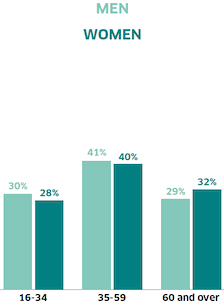
This bar chart shows the proportion of men and women in each of the following age groups: people aged 16 to 34, people aged 35 to 59 and people aged 60 or over. It shows that there were more men in the younger age group, and more women in the older age group in 2019.
47% of adults in Scotland were married or in a civil partnership
38% of adults were single, or had never been married or in a civil partnership in 2019
In 2019, 11% of adults self-identified as being from an ethnic group other than ‘White: Scottish’ or ‘White: Other British’. This figure has increased from 8% in 2013.
There was a significantly lower proportion of young adults aged 16 to 34 in rural areas compared to all other age groups.
The proportion of adults aged 16 and 24 had been consistently low since 1999, with 14% of adults in this age group living in rural areas 2019.
The proportion of adults aged 25 to 34 living in rural areas had decreased from 15% in 1999 to 12% in 2019.
The proportion of other age groups living in rural areas had been consistent between 1999 and 2019.
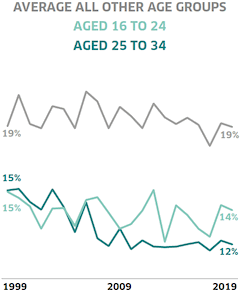
This line graph shows the proportion of people aged 16 to 24 and 25 to 34 living in rural areas, and how this changed between 1999 and 2019. It also has a line representing the average proportion of people living in rural areas for all other age groups, which was significantly higher than the average for younger adults.
83% of Scottish households were in urban areas
In 2019, 2 in 5 households in Scotland were either single adult or small adult families - making these the most common hosuehold types.
This indicates that more people were either living alone, or with one other person without children.
The proportion of single adult households had increased more among households in the 20% lowest income group than in the 20% highest income group.
The decrease in single older households was larger in the 20% lowest income group, decreasing from 43% of households in this income bracket in 1999 to 32% in 2019.
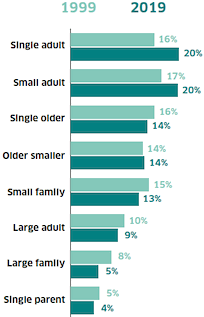
This vertical bar chart shows the proportion of different household types in 1999 and 2019. They are ordered according to how common they were in 2019, meaning that they appear in the following order: single adult households, small adult households, single older households, older smaller households, small family households, large adult households, large family households and single parent households. Single adult households, small adult households and large family households show the biggest difference between 1999 and 2019.
19% Of households with children were single parent households, while 57% were small families
The proportion of single parent households had decreased from 23% of households with children in 2012 to 19% in 2019
It should be noted that the definition of a single parent does not make any distinction between situations where a child has regular contact and/or partly resides with their other parent and a child who solely resides with and is cared for by one parent
Overall, 24% of adults in Scotland lived with long-term physical or mental health conditions that limited their daily life.
In areas with a higher level of deprivation, more people lived with a limiting condition. In the most deprived areas in Scotland, 33% of adults lived with a limiting condition, while 15% of adults lived with a limiting condition in the least deprived areas.
Generally, among the older age groups a larger proportion of people lived with a limiting health condition, including 51% of those aged 75 or over.
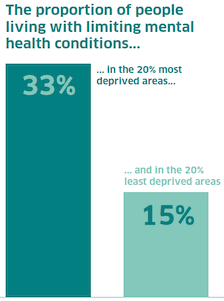
This bar chart shows the difference between the proportion of people living with a limiting physical or mental health condition in the 20% most and 20% least deprived areas in Scotland, highlighting that more adults live with limiting conditions in more deprived areas.
14% of young adults lived with a limiting physical or mental health condition
This was a significant increase from 2013, when the figure was 10%
The trend of declining religious belonging continued in 2019, with 56% of adults reporting that they did not belong to any religion.
This coincided with a sharp decrease since 2009 in the proportion of people who report that they belong to the Church of Scotland, from 34% to 20% of adults.
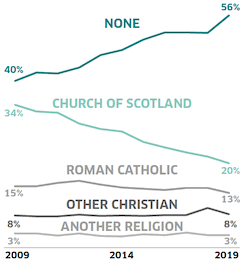
This line graph shows five types of religious belonging, and how the proportion of adults identifying as belonging to these religions changed between 2009 and 2019. The labels are as follows, with the most common in 2019 listed first: “None”, “Church of Scotland”, “Roman Catholic”, “Other Christian”, and “Another Religion”. The graph shows no religious belonging as increasing and the Church of Scotland as decreasing with time, while the other three have been consistent.
7 in 10 adults aged 16 to 34 said that they did not belong to a religion
Adults aged 60 or over were significantly more likely to belong to Church of Scotland than any other age groups
This data has only been collected since 2009.
Contact
Email: shs@gov.scot
There is a problem
Thanks for your feedback